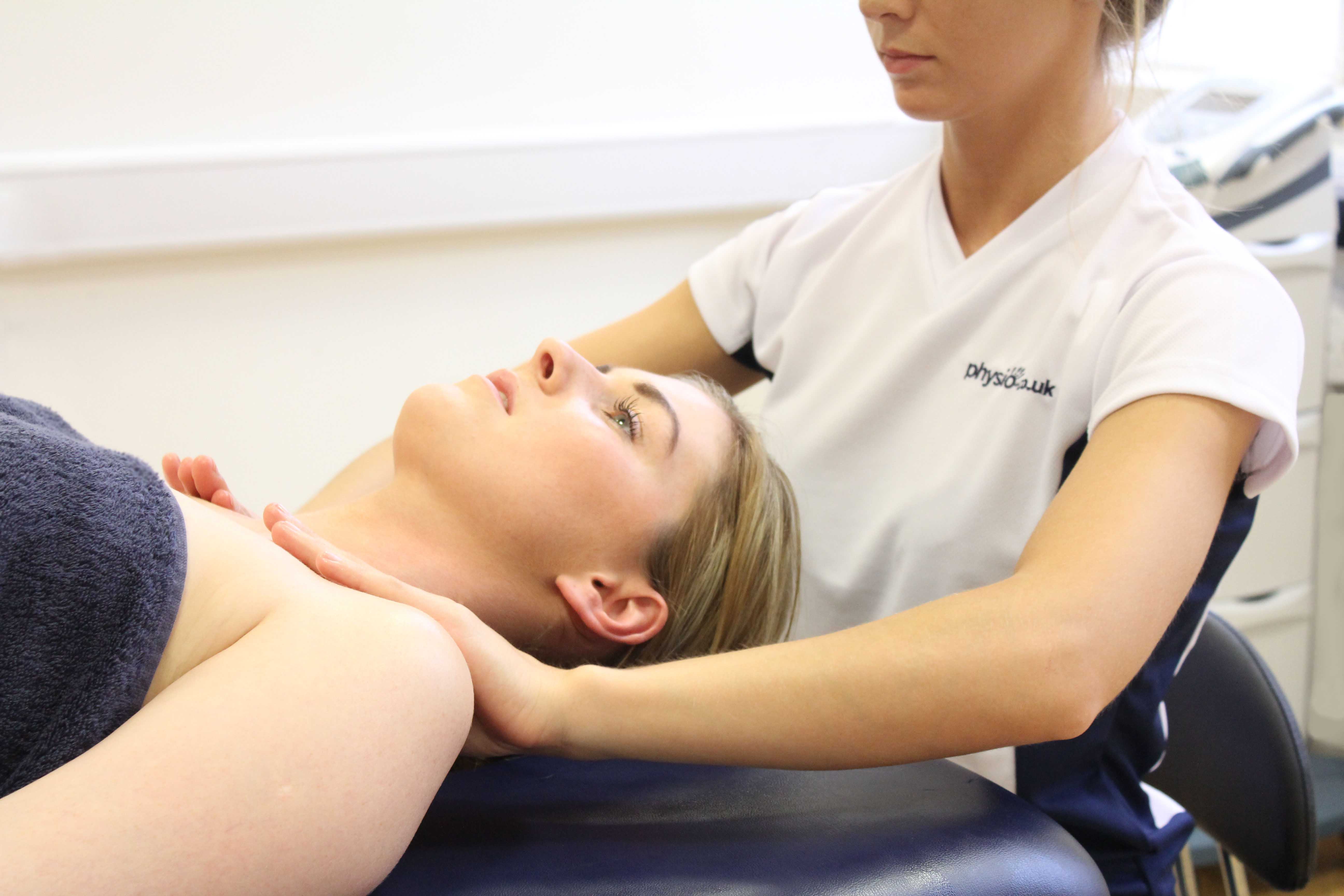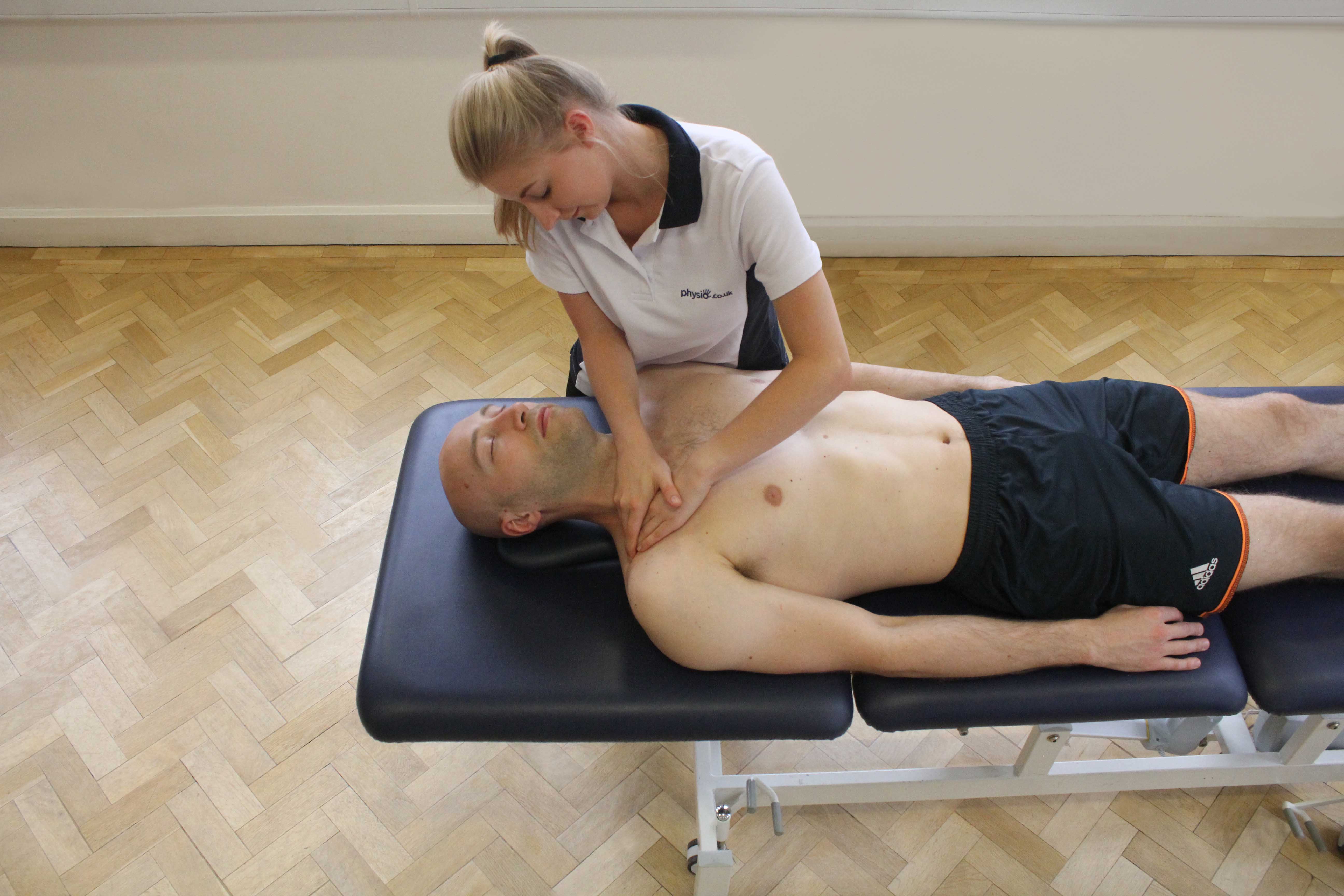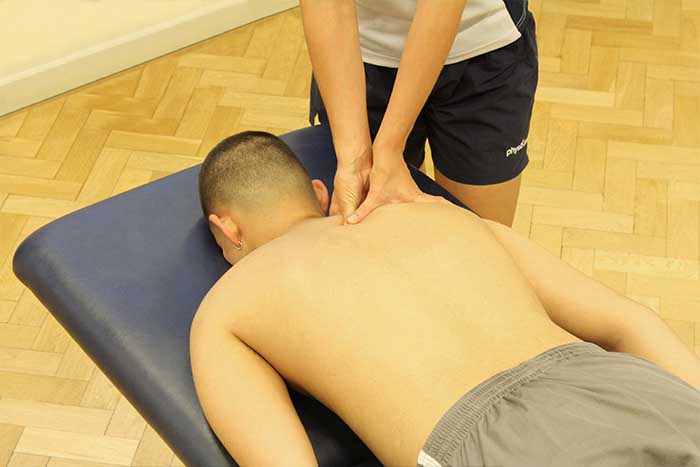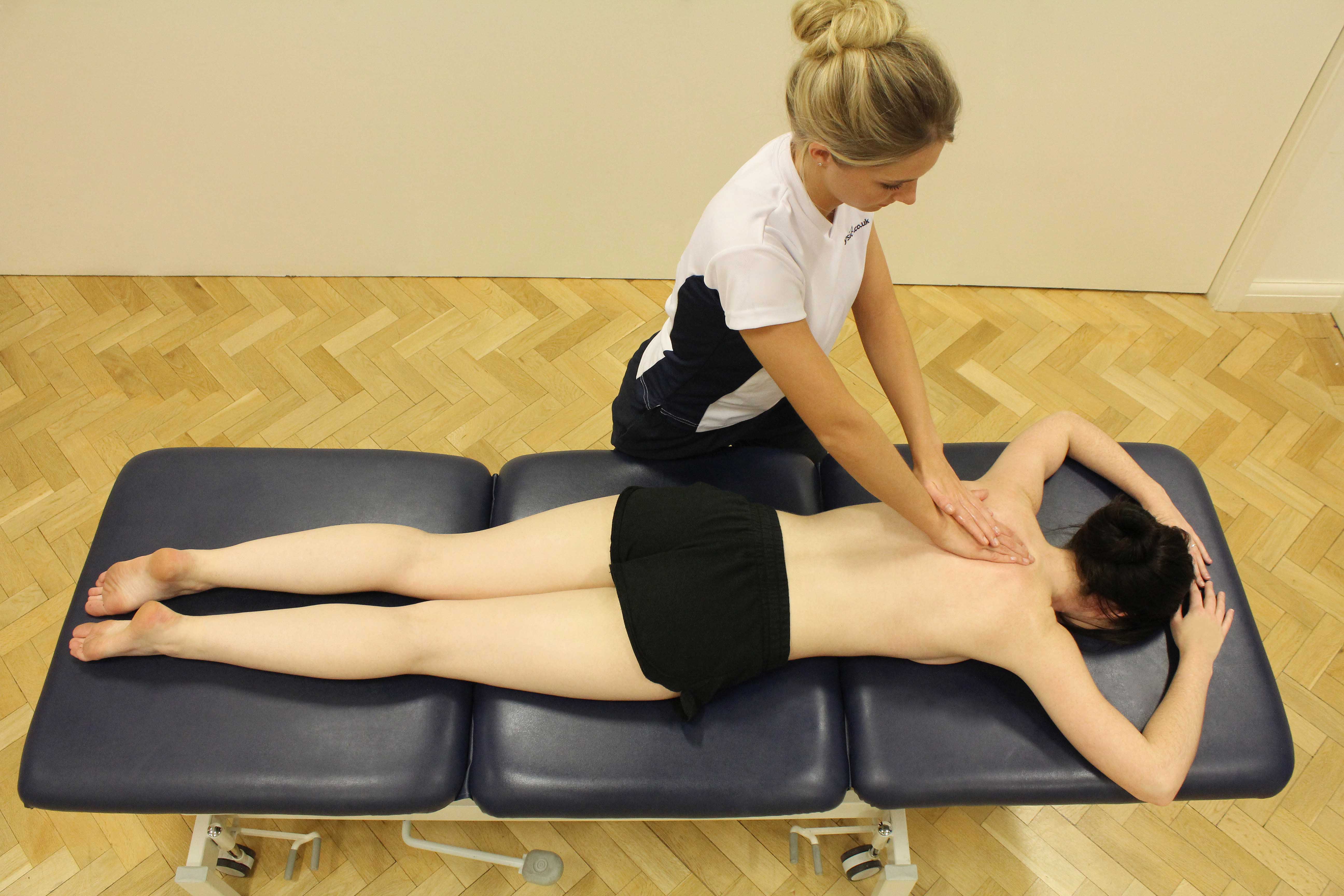A shoulder massage focuses on the muscles located around the shoulder region. The muscles of the shoulder region consist of the upper trapezius, rhomboids and rotator cuff muscles. A shoulder massage involves many different techniques that help reduce tightness and pain. A shoulder massage helps increase the temperature of the muscles by increasing blood flow. Increased temperature in the muscles results in relaxation and decreased pain. Our highly trained massage therapists at Physio.co.uk use shoulder massage to help relieve stress, tension and pain.
What techniques are used in a shoulder massage?
There are a variety of different techniques that are used during a shoulder massage. The most common techniques used during a shoulder massage include:
 Above: Soft tissue massage applied to the shoulders
Above: Soft tissue massage applied to the shouldersAcupressure is commonly used during a shoulder massage. Acupressure is a technique performed using the thumb or fingertips on trigger points and muscular knots. Acupressure helps increase blood flow to the shoulder muscles. Pressure applied to the muscular knots stops the blood flow to this area. The muscular knot is broken down and softened as the pressure is applied. When the pressure has been released, the body's natural healing process is activated as it thinks an area of the body has been damaged. The body's natural healing process encourages more blood flow to the shoulders to provide the muscles with more oxygen and nutrients needed for healing. Acupressure helps aid pain relief and results in relaxation of the muscles located within the shoulder region.
Kneading is used on the muscles during a shoulder massage. Kneading can be performed using flat hands or fists. Blood and lymph flow is improved by slowly squeezing and pulling the soft tissues. Friction created from pulling and squeezing the soft tissues increases the temperature of the muscles and improves elasticity. Increasing the elasticity of the muscles results in an improvement of flexibility. An improvement of elasticity and flexibility therefore results in a decrease of muscle pain, tightness and tension.
Effleurage is used during a shoulder massage. Effleurage is a technique that can be performed using flattened hands and fingers. The pressure when using effleurage can vary according to personal preference. Effleurage can be a relaxing experience and can help relieve stress, pain and tightness within the shoulders. Effleurage helps increase the temperature of the muscles, improving blood flow around the body. Temperature is increased by the friction created from rubbing the skin. Increasing the temperature and improving blood flow helps increase the elasticity of the muscles. An increase of elasticity of the muscle helps reduce muscle tightness and tension. Effleurage also helps increase the removal of waste products and toxins by improving the lymphatic circulation.
An effective technique commonly used during a shoulder massage is skin rolling. Skin rolling is where skin is picked up and rolled between both the fingers and thumbs. Skin rolling helps relieve stress and tension within the muscles. Skin rolling aids in the improvement of the circulation of blood and lymph flow. An improvement in lymph flow aids in the removal of waste products and toxins within the muscles and tissues.
Trigger pointing is effectively used during a shoulder massage. A trigger point is found in the middle of a muscle fibre. A trigger point can cause pain in the body if not treated. Trigger pointing during a shoulder massage is where pressure is placed on the trigger points to help soften knots that could be causing pain in the upper back area. Softened knots are a result of the pressure placed on the trigger points, and blood flow being restricted to this area. When the blood flow is restricted, this is called an ischemic reaction. When pressure is released, the body's natural healing process immediately sends blood to this area. Blood flow is increased to repair damage the body thinks has occurred. An increase in blood flow provides the muscle with healthy nutrients and oxygen which aids in the maintenance of strong and healthy muscles.

When can a shoulder massage help?
A shoulder massage can help in many different ways. Different ways a shoulder massage can help include:
 Above: Soft tissue massage trapezius and anterior deltoid
Above: Soft tissue massage trapezius and anterior deltoidA shoulder massage can encourage relaxation. A shoulder massage can relax the body physically and mentally. Muscles in the shoulder can become tight and painful resulting in the body not being relaxed. A shoulder massage creates friction and increases the temperature of the muscles. Increasing the temperature helps improve the elasticity within the muscles resulting in less muscle tightness and tension. Reduced muscle tightness and tension helps the body relax as pain is decreased. A shoulder massage also helps the body to mentally relax. During a shoulder massage, the relaxation hormones serotonin and dopamine are increased. Serotonin and dopamine help the body be calm and relaxed. A decrease of the hormone cortisol also occurs. Cortisol increases stress within the body. Increasing serotonin and dopamine and decreasing cortisol levels help the body to mentally relax.
Stress can be treated by a shoulder massage. Stress can affect the body both mentally and physically. Tension in the muscles is one of the most common signs of stress. Shoulder massage helps decrease the levels of the stress hormone cortisol. An increase of the hormones serotonin and dopamine also occurs to help the body become calm and stress free. A decrease in cortisol and increase in serotonin and dopamine helps the body to mentally relieve stress. A decrease in muscle tightness and tension also occurs. A shoulder massage increases the temperature of muscles, loosening tightness, relieving tension and physically reducing stress.
A shoulder massage can help decrease tightness of muscles that cause pain and discomfort. The most common reasons of tight muscles include poor posture and injury. Tightness of the muscles in the shoulders can result in high levels of pain and discomfort that can negatively affect everyday life. A shoulder massage increases the temperature of muscles resulting in the improvement of tissue elasticity and flexibility. Improving tissue elasticity within the muscles results in reduced muscle tightness.
Injury can have many negative effects on the body. Negative effects caused as a result of injury can be helped by receiving a shoulder massage. After an injury, muscles can become tight and restrictive causing an increase in pain. A shoulder massage helps ease tension, stress and pain. A shoulder massage helps break down and reduce scar tissue that is formed around an injury site. The breakdown of scar tissue results in improved muscle function. Tissue elasticity is increased therefore improving flexibility and range of movement around a joint.

What are the benefits of a shoulder massage?
There are a variety of different benefits that can be achieved using a shoulder massage. The benefits of a shoulder massage are:
 Above: Soft tissue massage of the trapezius and erector spinae muscles
Above: Soft tissue massage of the trapezius and erector spinae musclesBenefits of a shoulder massage include decreased pain, improved circulation, prevention of injury and improved posture.
Decreased pain is one of the most common benefits of a shoulder massage. Muscles in the shoulders can become sore and painful due to a variety of reasons. The most common reasons include poor posture, injury and overuse. Muscles become tense and tighten resulting in an increase in muscle soreness. Muscle soreness occurs, as receptors in the body detect when something is wrong. Once detected, a signal is sent to the brain. This signal tells the brain that there is pain. When this message is received, this is when we start to feel an increase of pain. A shoulder massage aims to reduce pain by stopping or interfering with the signals that get sent to the brain. Stopping the signals means that the body cannot detect the pain any more so pain is reduced. As well as stopping signals to the brain, a shoulder massage also helps loosen muscles and relieve tightness. Massage increases the temperature of the muscle which results in the increase of capillarisation on vasodilation. An increase in capillarisation increases the amount of oxygen that can be used by the body. An Increase in vasodilation increases the size of the blood vessels so that blood flow is increased. An increase of temperature within the muscles results in the improvement of muscle elasticity. An improvement of muscle elasticity reduces tightness and tension and therefore decreases pain.
A shoulder massage can help improve the circulation of blood. Improving the blood circulation encourages more nutrients and oxygen to be delivered to the muscles. An increase in nutrients and oxygen keeps muscles healthy and can prevent injury. An increase in cellular exchange also occurs. Cellular exchange is where waste products and toxins are removed as healthy nutrients and oxygen are given. Removing waste products and toxins more efficiently helps keep the muscles healthy and it is less likely for circulation to be decreased.
Prevention of injury is another common benefit of a shoulder massage. Due to the improvement of the blood and lymphatic circulation, there are less harmful products and toxins within the muscles that can damage the muscles. An increase in oxygen and nutrients are also being circulated around the muscles. An increase in oxygen and nutrients aids in stronger and healthier muscles. An increase in muscle temperature improves tissue elasticity and flexibility around the joints. An increase of range of movement means that during strenuous activity, the muscles are able to move with less restriction therefore preventing injury.
Posture can be improved after a shoulder massage. When muscles become tense or tighten, they cause pain and discomfort within the body. When muscles become painful, they restrict the range of movement. A restriction of range of movement can cause poor posture. A shoulder massage helps loosen tight muscles by increasing the temperature, improving elasticity and flexibility of the muscles. Improvement of elasticity and flexibility increases range of movement and decreases pain. An increase in range of movement and decrease in pain allows the posture to correct itself without causing any pain or discomfort.
 Above: Soft tissue massage of the temporomandibular joint
Above: Soft tissue massage of the temporomandibular jointSummary
A shoulder massage focuses on the muscles located around the shoulder region. There are many different techniques commonly used during a shoulder massage including acupressure, kneading, effleurage and skin rolling. A shoulder massage effectively reduces pain, stress, tension and tightness in the shoulder muscles. A shoulder massage increases the temperature of muscles to improve the circulation of the blood and lymph flow. Our highly trained massage therapists at physio.co.uk use shoulder massage to treat stress and muscle tightness to help decrease pain.
How can I arrange a shoulder massage?
The easiest way to arrange a Shoulder massage at Physio.co.uk is to email us at office@physio.co.uk or call us on 0800 033 7800.
Alternatively if you have any questions please feel free to contact us.
We offer a 7 day service and provide home and clinic appointments.

 0330 088 7800
0330 088 7800



































